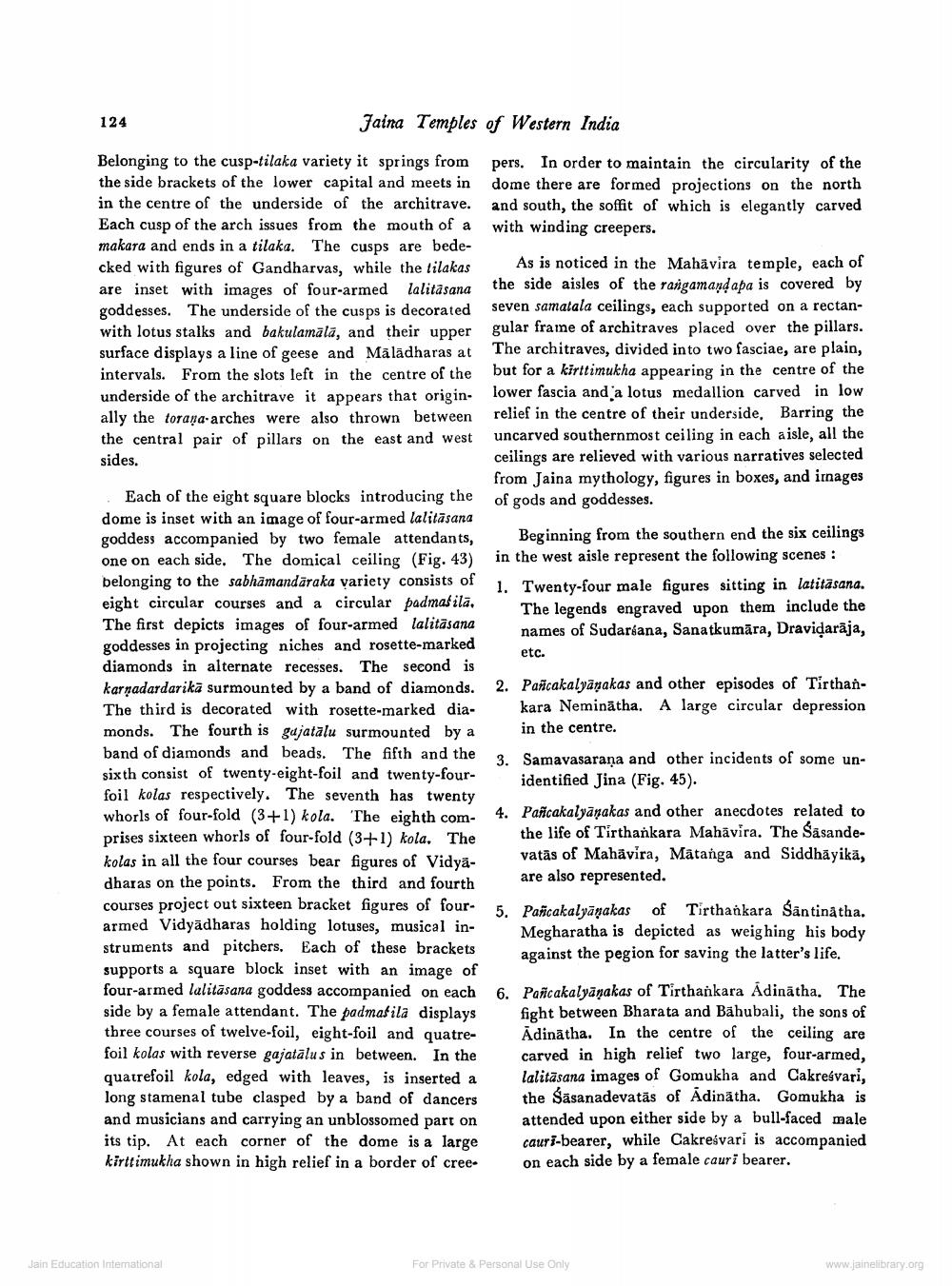________________
124
Faina Temples of Western India
pers. In order to maintain the circularity of the dome there are formed projections on the north and south, the soffit of which is elegantly carved with winding creepers.
Belonging to the cusp-tilaka variety it springs from the side brackets of the lower capital and meets in in the centre of the underside of the architrave. Each cusp of the arch issues from the mouth of a makara and ends in a tilaka. The cusps are bedecked with figures of Gandharvas, while the lilakas are inset with images of four-armed Lalitasana goddesses. The underside of the cusps is decorated with lotus stalks and bakulamala, and their upper surface displays a line of geese and Mäladharas at intervals. From the slots left in the centre of the underside of the architrave it appears that origin. ally the torana.arches were also thrown between the central pair of pillars on the east and west sides.
As is noticed in the Mahavira temple, each of the side aisles of the rangamand apa is covered by seven samatala ceilings, each supported on a rectangular frame of architraves placed over the pillars. The architraves, divided into two fasciae, are plain, but for a kiritimukha appearing in the centre of the lower fascia and a lotus medallion carved in low relief in the centre of their underside, Barring the uncarved southernmost ceiling in each aisle, all the ceilings are relieved with various narratives selected from Jaina mythology, figures in boxes, and images of gods and goddesses.
Beginning from the southern end the six ceilings in the west aisle represent the following scenes : 1. Twenty-four male figures sitting in latita sana.
The legends engraved upon them include the names of Sudarsana, Sanatkumāra, Draviďarāja, etc.
2. Pancakalyanakas and other episodes of Tirthan
kara Neminātha. A large circular depression in the centre.
3. Samavasarana and other incidents of some un
identified Jina (Fig. 45).
Each of the eight square blocks introducing the dome is inset with an image of four-armed lalitāsana goddess accompanied by two female attendants, one on each side. The domical ceiling (Fig. 43) belonging to the sabhämandāraka variety consists of eight circular courses and a circular padmašila. The first depicts images of four-armed lalitāsana goddesses in projecting niches and rosette-marked diamonds in alternate recesses. The second is karnadardarikā surmounted by a band of diamonds. The third is decorated with rosette-marked diamonds. The fourth is gujatālu surmounted by a band of diamonds and beads. The fifth and the sixth consist of twenty-eight-foil and twenty-four- foil kolas respectively. The seventh has twenty whorls of four-fold (3+1) kola. The eighth com. prises sixteen whorls of four-fold (3+1) kola. The kolas in all the four courses bear figures of Vidyadharas on the points. From the third and fourth courses project out sixteen bracket figures of four. armed Vidyadharas holding lotuses, musical instruments and pitchers. Each of these brackets supports a square block inset with an image of four-armed lalitāsana goddess accompanied on each side by a female attendant. The padmašila displays three courses of twelve-foil, eight-foil and quatre- foil kolas with reverse gajatālus in between. In the quatrefoil kola, edged with leaves, is inserted a long stamenal tube clasped by a band of dancers and musicians and carrying an unblossomed part on its tip. At each corner of the dome is a large kirttimukha shown in high relief in a border of cree
4. Paficakalyanakas and other anecdotes related to
the life of Tirthankara Mahāvira. The Säsandevatās of Mahāvira, Mātanga and Siddhāyikā, are also represented.
5. Pafcakalyānakas of Tirthankara Santina tha.
Megharatha is depicted as weighing his body against the pegion for saving the latter's life.
6. Pancakalyanakas of Tirthankara Adinātha. The
fight between Bharata and Bahubali, the sons of Adinātha. In the centre of the ceiling are carved in high relief two large, four-armed, lalitasana images of Gomukha and Cakresvari, the Sāsanadevatās of Adinātha. Gomukha is attended upon either side by a bull-faced male cauri-bearer, while Cakreśvari is accompanied on each side by a female cauri bearer.
Jain Education International
For Private & Personal use only
www.jainelibrary.org




